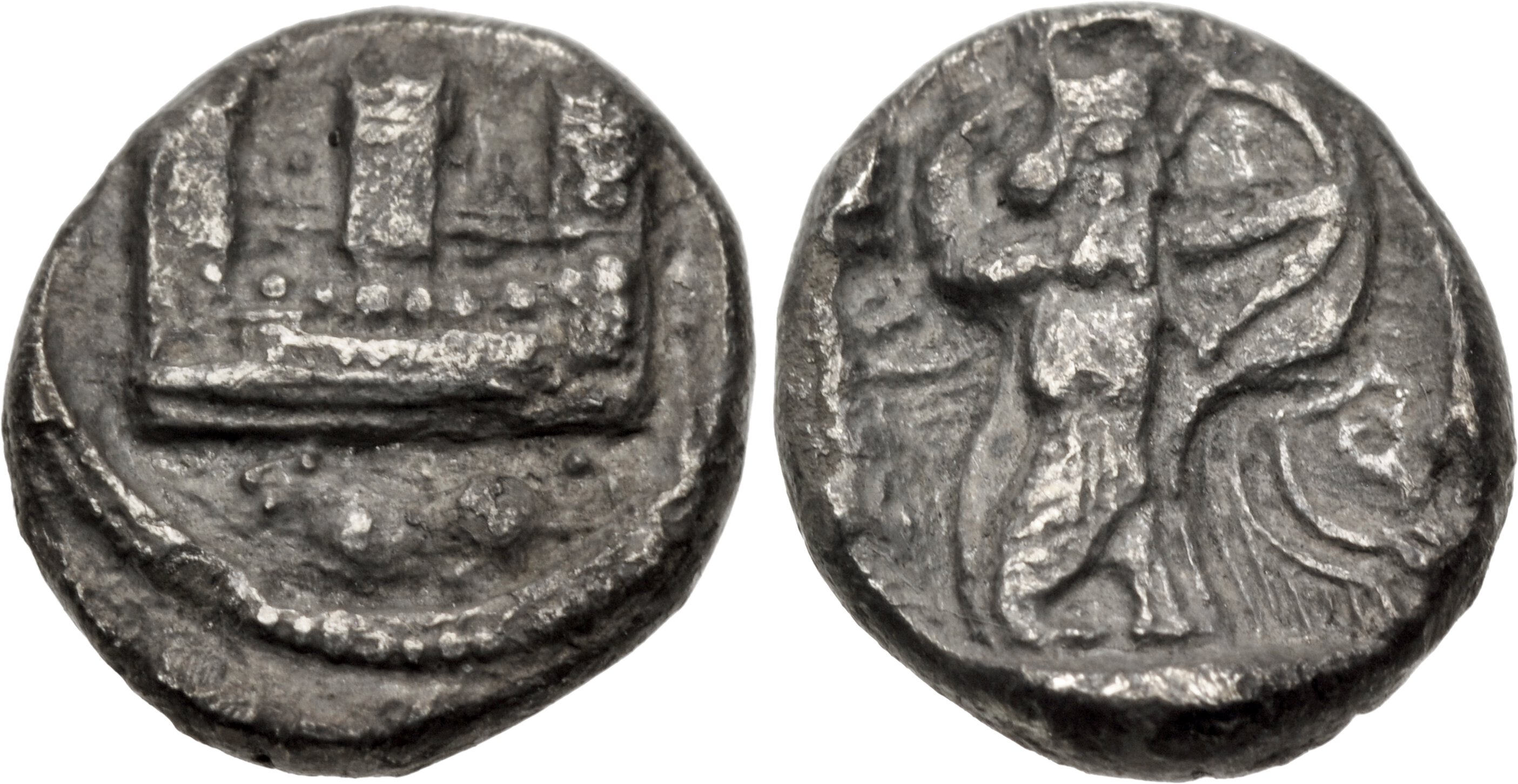Sidon (uncertain king), silver, 16th shekels (425-402 BCE)
From SILVER
425 BCE - 402 BCE Silver 662 kg
Description
| ObverseInscription or printing placed on the obverse.: | Phoenician galley left before city wall with three towers, in exergue, lion couchant left |
| ReverseInscription or printing placed on the reverse.: | King of Persia standing right, drawing bow, quiver over shoulder, to left, incuse head of satyr left, to right, incuse head of goat right, all within incuse square |
Mint and issuing power
| MintIdentifies the place of manufacture or issue of a numismatic object.: | Sidon | Ancient regionAncient region.: | Phoenicia | Modern countryModern country: Lebanon | AuthorityIdentifies the issuing power. The authority can be "pretended" when the name or the portrait of X is on the coin but he/she was not the issuing power. It can also be "uncertain" when there is no mention of X on the coin but he/she was the issuing power according to the historical sources: | Persian Empire |
Chronology
| FromIdentifies the initial date in a range assigned in a numismatic context. | 425 BCE | toIdentifies the final date in a range assigned in a numismatic context.. | 402 BCE | PeriodTime period of the numismatic object.: Classical 480-323 BC |
Physical description
| MetalThe physical material (usually metal) from which an object is made.: | Silver |
Median weightMedian of the weights of numismatic objects (in grams). in grams | 0.85 | DenominationTerm indicating the value of a numismatic object. Examples: tetradrachm, chalkous, denarius.: | 16th shekel | StandardStandard.: | Persian |
Image

S1886 Sidon 16th shekel III.3.jpg [1]
References
| Die study referencePublication of the study: | Elayi - Elayi 20041Elayi - Elayi 2004, p. 81-89, n° 362-449 (Group III.3) | ||
| Coin series referenceReference to coin series study: | Sear II2Sear II, n° 5933, HGC 103HGC 10, n° 230 | ||
| Coin series web referenceCoin series web references: | |||
Obverse dies distribution
| FrequencyFrequency of specimen in distribution. ᵖ | Number of obversesNumber of obverse dies. ᵖ (o) | % (o) | Number of coinsNumber of coins. (n) | % (n) | Die nameName(s) of the die(s). |
| 1 | 12 | 50 | 12 | 25 | 2, 4, 5, 6, 11, 14, 18, 20, 21, 22, 23, 1B |
| 2 | 5 | 20.83 | 10 | 20.83 | 3, 8, 13, 16, 17 |
| 3 | 5 | 20.83 | 15 | 31.25 | 1, 7, 9, 15, 19 |
| 4 | 1 | 4.17 | 4 | 8.33 | 10 |
| 7 | 1 | 4.17 | 7 | 14.58 | 12 |
| Total | 24 of 24 | 100 | 48 of 48 | 99.99 |
Reverse dies distribution
no distribution is available
Quantification
| Number of obversesNumber of obverse dies. ᵖ (o) | 24 | Number of singletons (o1)The number of singleton coins. ᵖ | 12 |
| Number of reverse diesNumber of reverse dies. (r) | 27 | Number of coinsNumber of coins. (n) | 48 |
| Coins per obverse dieNumber of coins per obverse die. (n/o) | 2 | Coins per reverse dieNumber of coins per reverse die. (n/r) | 1.78 |
| Reverse per obverse ratioRatio of obverse dies divided by reverse dies. (r/o) | 1.13 | Percentage of singletons (o1)number of coins (n) divided by the number of singletons (o1) ᵖ | 50 % |
| Original number of dies (O) (Carter 1983 formula)The estimation of the number of coins according to Carter 1983 ᵖ | 38.96 | Coins struck if 20,000 as average productivity per dieCoins made if the average productivity for obverses (according to Carter) is 20,000. ᵖ | 779,200 |
| Original number of dies (O) (Esty 2011 formula)The estimation of the number of coins according to the singleton formula in Esty 2011 ᵖ (O) | 48 | Survival rate if 20,000 as average productivity per dieSurvival rate if average productivity is 20,000. ᵖ | 0.00006 |
| Coverage (o = % of O) (Esty 1984 formula)Esty 1984 - coverage (% of O) ᵖ (o = % of O) | 75% | Die productivity if survival rate 1/2,000Average productivity if survival rate is 1/2,000. ᵖ | 2,464.07 |
| Weight of silver (in kg) if 20,000 coins per die (O = Carter formula)Carter 1983 * Median weight * 20000 (*10 if gold or electrum) ᵖ | 662 kg <br /> 662 kg | Die productivity if survival rate 1/5,000Average productivity if survival rate is 1/5,000. ᵖ | 6,160.16 |
Remarks
References
- ^ Elayi, Josette - Elayi, Alain G. (2004), Le monnayage de la cité phénicienne de Sidon à l'époque perse (Ve-IVe s. av. J.-C.), Transeuphratène Suppl. 11, Paris, Gabalda, 2 v., 855 p., 77 pl.
- ^ Sear, David R. (1979), Greek coins and their values. Vol. II, Asia and North Africa, London, xlviii, p. 317-762
- ^ Hoover, Oliver D. (2010), The Handbook of Greek Coinage Series. 10. handbook of coins of the Southern Levant : Phoenicia, southern Koile Syria (including Judaea), and Arabia, Lancaster-London, lxxix, 201 p.